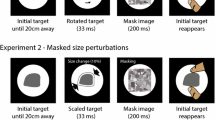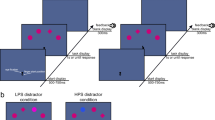Abstract
In the present study we addressed the issue of how an object is visually isolated from surrounding cues when a reaching-grasping (prehension) movement towards it is planned. Subjects were required to reach and grasp an object presented either alone or with a distractor. In five experiments, different degrees of elaboration of the distractor were induced by varying: (1) the position of the distractor (central or peripheral); (2) the time when the distractor was suppressed (immediately or delayed, with respect to stimulus presentation); and (3) the type of distractor analysis (implicit or explicit). In addition, we tested whether the possible effects of the distractor on reaching-grasping were due to the use of an allocentric reference centered on it. This was obtained by comparing the effects of the distractor with those of a stimulus, the target of a placing movement successive to the reaching-grasping. The results of the five experiments can be summarized as follows. The necessary condition for an interference effect on both the reaching and the grasping components was the central presentation of the distractor. When the information on the distractor could be immediately suppressed, an interference effect was observed only on the grasp component. In the case of delayed suppression, an effect was found on the reaching component. Finally, when an overt analysis of the distractor was required, the interference effect disappeared. Two main conclusions have been drawn from the results of the present study. First, comparison between properties of the target and surrounding cues is performed by two independent processes for reaching and grasping an object. The process for the grasp relies more on allocentric cues than that for the reach. Second, when surrounding stimuli are automatically analyzed during visual search of the target, the process of visuo-motor transformation can incorporate their features into the target. In contrast, overt analysis of surrounding stimuli is performed separately from that of the target. Finally, the data of the present study are discussed in support of the premotor theory of attention.
Similar content being viewed by others
Author information
Authors and Affiliations
Additional information
Received: 31 December 1997 / Accepted: 3 June 1998
Rights and permissions
About this article
Cite this article
Gangitano, M., Daprati, E. & Gentilucci, M. Visual distractors differentially interfere with the reaching and grasping components of prehension movements. Exp Brain Res 122, 441–452 (1998). https://doi.org/10.1007/s002210050532
Issue Date:
DOI: https://doi.org/10.1007/s002210050532




